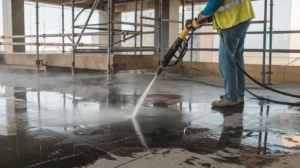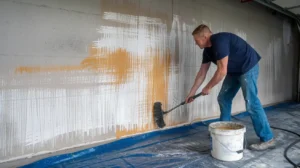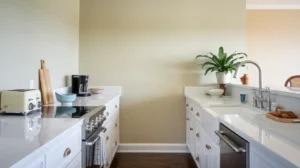When it comes to kitchen or bathroom renovations, a common question arises. Can you paint marble countertops? The short answer is yes. Painting marble countertops is possible and can be an affordable way to update your space without the high cost of replacement.
Whether you’re dealing with genuine marble, cultured marble, or faux marble, the process is similar but requires attention to detail and the right materials.

How to Paint Marble Countertops
If you’ve decided to paint your marble countertops, the first step is to gather the necessary materials. You’ll need grit sandpaper, painter’s tape, a paint kit designed for countertops, and epoxy paint. Here’s a step-by-step guide to help you through the process.
Prepare the Surface
To prepare your countertop for painting, begin by thoroughly cleaning it to remove any dust, dirt, and grease, as these can prevent the paint from adhering properly. After cleaning, lightly sand the surface using grit sandpaper.
This step is essential as it creates a slightly rough texture, which allows the paint to bond more effectively with the countertop, ensuring a smoother and longer-lasting finish.
Tape Off the Edges
To achieve a clean and professional paint job, use painter’s tape to cover areas you don’t want to paint, like sinks, faucets, and surrounding walls. Carefully apply the tape along the edges to create a barrier, preventing accidental paint splatters or smudges.
This simple step not only protects surfaces but also ensures crisp, neat lines and a polished finish, making your project look expertly done. Taking the time to tape off the edges can save you from messy clean-ups and give your work a more refined appearance.
Apply a Primer
Before painting, apply a primer specifically designed for countertops. This essential step ensures the paint adheres properly to the surface, creating a strong bond between the paint and the countertop. The primer also helps to create a smooth, even base, which improves the paint’s durability and overall finish.
By using a primer, you reduce the chances of peeling, chipping, or other wear and tear, extending the life of your newly painted countertop. Skipping this step could lead to a less durable and less professional-looking result.
Paint the Countertop
Once the primer is dry, you can start painting. Use a paint kit that includes all the necessary materials. Apply the base coat of paint evenly across the surface. Depending on the look you want to achieve, you may need multiple coats. Make sure to let each coat dry completely before applying the next.
Create a Marble Effect (Optional)
If you want your countertops to look like marble, you can create a veining effect using gray paint or another color of your choice. A small brush or a feather can help you achieve the natural, flowing lines that mimic real marble. Practice on a piece of cardboard first to perfect your technique.
Seal the Surface
Once the paint is fully dry, apply a coat of epoxy paint or a clear sealer to the surface. This essential step shields the countertop from scratches, stains, and moisture, preserving its appearance and durability. The sealer also enhances the finish, giving the surface a glossy, professional look.
Cure the Surface
After sealing your countertop, let the surface cure for at least 24 hours before using it. This curing period allows the sealant to fully set and bond with the material, ensuring maximum protection. During this time, avoid placing any heavy objects on the countertop, as this can cause dents or other damage while the sealant is still curing.
By allowing the surface to cure undisturbed, you help maintain its durability and appearance, ensuring a longer-lasting finish that resists stains and wear.
Can You Paint Countertops to Look Like Marble?
Yes, you can paint countertops to look like marble, whether they’re made of laminate, granite, or another material. The process involves using a marble countertop paint kit that typically includes base paint, veining paint, and a sealer. By carefully applying these paints, you can achieve a faux marble look that’s surprisingly realistic.
One of the most popular techniques is using a sponge or feather to create the veining effect. This method allows you to mimic the unique patterns found in real marble. With some practice and patience, you can transform an old, worn countertop into something that resembles luxurious marble.
Can You Paint Cultured Marble Countertops?
Can you paint cultured marble countertops? Absolutely. Cultured marble countertops are made from a blend of marble dust and resin, which gives them a similar appearance to natural marble. Painting cultured marble is similar to painting natural marble, but it’s important to note that the surface of cultured marble is non-porous.
This means you’ll need to sand the surface thoroughly to ensure the paint adheres properly.After sanding, follow the same steps as you would with natural marble: apply a primer, paint, and then seal the surface with an epoxy paint or clear sealer. Cultured marble counters can benefit greatly from a fresh coat of paint, especially if they’ve become outdated or damaged over time.
Hire a Stone Sealer for Your Marble Countertop Needs
Choosing Stone Sealer for your marble countertop needs ensures long-lasting protection and enhanced beauty. Our specialized sealer forms a robust barrier against stains, spills, and etching, preserving the natural elegance of your marble.
Unlike other products, Stone Sealer is engineered specifically for marble, penetrating deep into the stone to provide a durable, invisible shield. This means your countertops stay looking pristine and require less maintenance over time.
Additionally, our formula is safe, non-toxic, and easy to apply, making it the ideal choice for both homeowners and professionals. Trust Stone Sealer to safeguard your marble surfaces and keep them looking their best for years to come.
Final Thoughts
Painting marble countertops is a cost-effective way to give your kitchen or bathroom a fresh, new look. Whether you’re working with natural marble, cultured marble, or another material, the process is straightforward and can be done with a few basic tools and some patience.
Remember to follow the steps carefully, from surface preparation to sealing, to ensure the best results. And if you’re looking for a truly professional finish, don’t hesitate to reach out to a stone sealer who can help you achieve the look you desire. Transform your space with our expert services contact us if you have any query or want to take our services.





